 |
BMJ 2005;330:1290 (4 June),
doi:10.1136/bmj.330.7503.1290 |
Childhood cancer in relation to distance from high voltage power
lines in England and Wales: a case-control study
|
Gerald Draper, honorary senior research fellow1,
Tim Vincent, research officer1, Mary E Kroll, statistician1,
John Swanson, scientific adviser2
1 Childhood Cancer Research Group, University of Oxford,
Oxford OX2 6HJ, 2 National Grid Transco plc, London WC2N 5EH |
Abstract
 Introduction Introduction
 Methods Methods
 Results Results
 Discussion Discussion
 Conclusions Conclusions
 Disclosures Disclosures
 References References
Objective: To determine whether there is an association
between distance of home address at birth from high voltage power lines and the incidence of
leukaemia and other cancers in children in England and Wales.
Design: Case-control study.
Setting: Cancer registry and National Grid records.
Subjects: Records of 29 081 children with cancer,
including 9700 with leukaemia. Children were aged 0-14 years and born in England and
Wales, 1962-95. Controls were individually matched for sex, approximate date of birth, and birth
registration district. No active participation was required.
Main outcome measures: Distance from home address at birth to
the nearest high voltage overhead power line in existence at the time.
Results: Compared with those who lived > 600 m from a line
at birth, children who lived within 200 m had a relative risk of leukaemia of 1.69 (95%
confidence interval 1.13 to 2.53); those born between 200 and 600 m had a relative risk of 1.23 (1.02
to 1.49). There was a significant (P < 0.01) trend in risk in relation to the reciprocal of
distance from the line. No excess risk in relation to proximity to lines was found for other
childhood cancers.
Conclusions: There is an association between childhood leukaemia
and proximity of home address at birth to high voltage power lines, and the apparent risk extends
to a greater distance than would have been expected from previous studies. About 4% of children
in England and Wales live within 600 m of high voltage lines at birth. If the association is
causal, about 1% of childhood leukaemia in England and Wales would be attributable to these lines,
though this estimate has considerable statistical uncertainty. There is no accepted biological
mechanism to explain the epidemiological results; indeed, the relation may be due to chance or
confounding. |
|
|
|
The electric power system produces extremely low frequency electric
and magnetic fields. Since 1979 there has been concern that these fields may be associated
with cancer.1
Concern has concentrated on magnetic rather than electric fields and on childhood leukaemia in
particular. A pooled analysis of nine studies that met specified quality criteria found that
children living in homes with 24 hour average fields of  0.4 ÁT have twice the risk of leukaemia.2
In 2001 the International Agency for Research on Cancer classified extremely low frequency magnetic
fields as "possibly carcinogenic" on the basis of "limited" epidemiological evidence
and "inadequate" evidence from animals.
0.4 ÁT have twice the risk of leukaemia.2
In 2001 the International Agency for Research on Cancer classified extremely low frequency magnetic
fields as "possibly carcinogenic" on the basis of "limited" epidemiological evidence
and "inadequate" evidence from animals.
Magnetic fields in homes arise mainly from low voltage distribution
wiring, house wiring, and domestic appliances. Only a small fraction of homes are close to
high voltage overhead power lines (transmission lines), but in these homes the power line is likely
to be the main source of magnetic field.
We investigated whether proximity of home address at birth to transmission
lines in England and Wales is associated with increased risks of childhood cancer. It is not
known which period of life, if any, is relevant to induction of cancer by magnetic fields. Previous
research has considered address at diagnosis or throughout some specified period. Over half (55%)
of cases of childhood leukaemia and 43% of other cancers in childhood occur by the age of 5
years. |
|
|
|
Cases and controls
Children aged 0-14 years with cancer (malignant neoplasms and tumours of the central nervous system and
brain) in England, Scotland, and Wales, ascertained through several sources including the
National Cancer Registration System and the UK Children's Cancer Study Group, are included in the
National Registry of Childhood Tumours at the Childhood Cancer Research Group.
We identified nearly 33 000 cases of childhood cancer in children born
in England and Wales, 1962-95, and diagnosed in England, Wales, or Scotland over the same period.
We obtained birth information for just over 31 000 cases, 1700 having been excluded because the
child was adopted or the birth record could not be traced. For each case we selected from birth
registers a control matched for sex, date of birth (within six months), and birth registration district.
Registration districts vary greatly in size and are frequently redefined; there are currently about
400. We attempted to find the postcode and approximate grid reference of the address at
birth for all cases and controls, but this was not always possible. The final dataset comprised
29 081 matched case-control pairs (9700 for leukaemia) that we could map with respect to transmission
lines.
Calculation of distance from power lines
We looked at overhead power lines forming the National Grid in England and Wales Ś that is, all 275
and 400 kV overhead lines (the highest voltages used) plus a small fraction of 132 kV lines,
about 7000 km altogether. We obtained the grid references of all 21 800 pylons concerned from the
records of National Grid Transco. Using the postcode at birth we identified subjects living
within 1 km of a transmission line. For 93% of these addresses we obtained, from the Ordnance
Survey product AddressPoint, a 0.1 m grid reference and hence calculated the shortest distance to
any of the transmission lines that had existed in the year of birth, re-creating previous locations of
lines when necessary and possible. For calculated distances less than 50 m, we took the
average of the nearest and furthest points of the building from the line, using large scale maps.
We aimed to obtain a complete set of accurate distances for all subjects within 600 m of a
line, a distance chosen to be well beyond that at which the magnetic field from the line is thought to
be important.
Statistical analysis
We used conditional logistic regression on the matched case-control pairs to calculate relative risks
and  2 values. 2 values. |
|
|
|
Table 1 shows the distribution of distances from the nearest line
for cases, subdivided into leukaemia, central nervous system/brain, and "other," and for
matched controls. Most (97%) of these distances were  600 m. The relative risk is an estimate of the incidence compared with that at distances
600 m. The relative risk is an estimate of the incidence compared with that at distances  600 m. For leukaemia, at each distance category < 600 m the relative risks are greater than
1.0; there is some evidence that the risk varies according to distance from the line, though there is
no smooth trend. For the other diagnoses, our data suggest no increased risk.
600 m. For leukaemia, at each distance category < 600 m the relative risks are greater than
1.0; there is some evidence that the risk varies according to distance from the line, though there is
no smooth trend. For the other diagnoses, our data suggest no increased risk. |
|
Table 1 Distance of address at birth from nearest National Grid
line for cases and controls in each diagnostic group, and estimated relative (RR) |
|
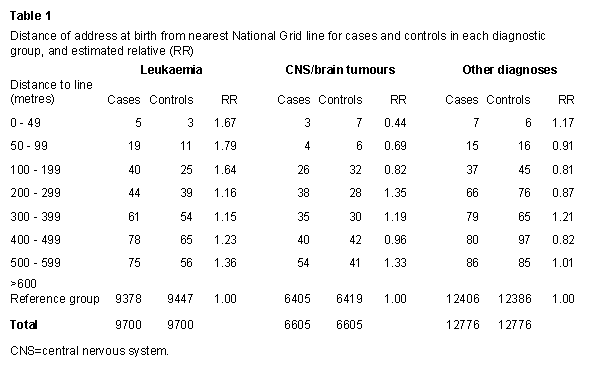
|
|
In general, emanations from a line source are expected to reduce in
strength as the reciprocal of distance, but the magnetic field from a power line generally falls as the
inverse square of distance, or sometimes the inverse cube.3
For each diagnostic group, we tested whether the risk is some function of distance (d)
from the nearest line (table 2),
using three models: that the risk depends on the rank of the distance band, the reciprocal of
the distance (1/d), or the inverse square (1/d2). There were no
significant results for central nervous system/brain tumours or for "other tumours."
For leukaemia, the results of two of the trend analyses were significant (P < 0.01); these analyses
suggest the risk might depend either on the rank of the distance category or on the reciprocal of
distance. The latter seems more plausible. |
|
Table 2 Tests of hypotheses relating trends in relative risks to
alternative measures of proximity to nearest line (based on the eight distance categories* in table
1). Figures are  2
for trend (with 1 df) and P value 2
for trend (with 1 df) and P value |
|
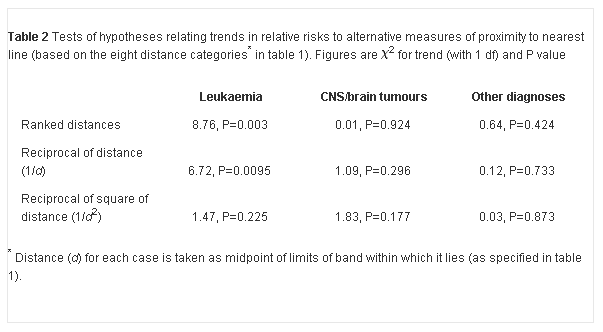
|
|
We therefore retabulated the results for leukaemia at
intervals corresponding to roughly equal intervals of 1/d (table
3). This change in the grouping of the data does not change the pattern of relative risk
estimates shown in table
1 or the significance of the test for trend with 1/d. For simplicity we
also analysed risk of leukaemia in bands 0-199 m and 200-599 m. The risks relative to  600 m were 1.69 and 1.23; the trend with 1/d was significant (P < 0.01).
600 m were 1.69 and 1.23; the trend with 1/d was significant (P < 0.01). |
|
Table 3 Relative risk (RR) estimates for leukaemia using revised
distance categories (see text) |
|
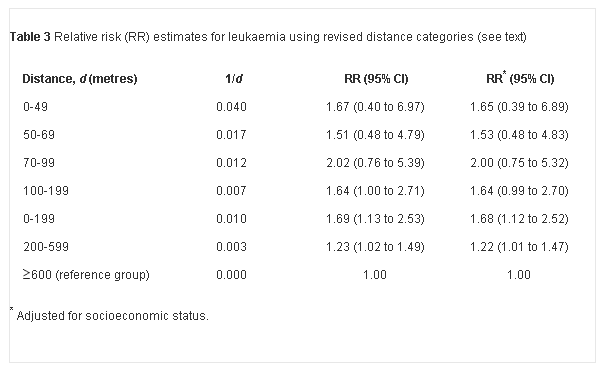
|
|
We examined the possibility that the relation between distance and
risk of leukaemia is a consequence of a relation between distance and socioeconomic status. We
used the Carstairs deprivation index to allocate a measure of socioeconomic status to the census ward
in which each child was living at birth.4
The results in table 4
confirm the previously reported association between affluence and risk of childhood leukaemia (P for
trend < 0.01).5
Adjustment for socioeconomic status had no effect on the relative risks for distance (table
3). |
|
Table 4 Relative risks for categories of socioeconomic status |
|
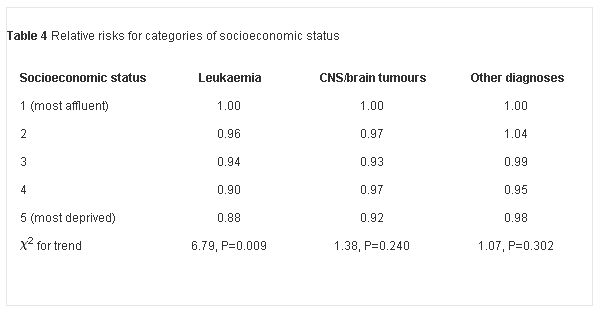
|
|
Power lines produce small air ions through a process known as "corona."
Fews et al suggest that this could lead to health effects when winds blow the ions away from the line.6
We have made an initial test of this hypothesis using a simple model suggested by Preece et
al (personal communication), assuming the prevailing wind is from the south west. The
case-control ratio was no greater downwind than upwind of power lines, so, using this
admittedly oversimplified approach, we have no evidence to support this hypothesis. |
|
|
|
To date this is the largest study of childhood cancer and power lines,
with roughly twice the number of children living close to power lines than in the next largest study.7
We found that the relative risk of leukaemia was 1.69 (95% confidence interval 1.13 to 2.53)
for children whose home address at birth was within 200 m of a high voltage power line compared with
those more than 600 m from the nearest line. For 200-600 m the relative risk was 1.23
(1.02 to 1.49). The finding that the increased leukaemia risk apparently extends so far from the
line is surprising in view of the very low level of magnetic field that could be produced by
power lines at these distances.
Possible explanations for findings
There is no obvious source of bias in the choice of cases or controls. The study is based on
records of childhood cancer in England and Wales over most of the period that the National Grid
has existed. Registration for childhood cancer is nearly complete, and it seems improbable that
the likelihood of registration is related to proximity of birth address to transmission lines.
Controls were selected from registers compiled through the legally required process of birth
registration. No participation by cases or controls was required. We calculated distances without
knowing case-control status, and we were able to include 88% of the eligible cases, each with a
matched control.
Populations near power lines may have different characteristics from
the rest of the population. In our control data there is a slight tendency in urban areas for
greater affluence (measured by the Carstairs index) closer to lines, though in rural areas there
is no clear trend. There is known to be a positive association between affluence and rates of
childhood leukaemia. However, adjustment for socioeconomic status of the census ward of birth
address did not explain our finding. Population mixing has been associated with childhood
leukaemia,8 but in
our cases individual mobility, measured by changes of postcode between birth and diagnosis,
was no more common for those whose home at birth was closer to the lines. Other characteristics
of the population (for instance parity, which has sometimes been found to be associated with
childhood leukaemia9)
may vary with proximity to power lines, but we do not have the data to determine whether these explain
our result.
The results are highly significant but could nevertheless be due
to chanceŚfor example, if the leukaemia controls are not sufficiently representative of the relevant
population. Some support for this explanation can be derived from the different distance
distributions observed for the leukaemia and non-leukaemia controls in table
1. Comparison of the leukaemia cases with the latter still suggests that there is an increased risk
for leukaemia but it is much lower than that found using the matched controls. We
emphasise, however, that the use of the matched controls is the most appropriate approach.
Six of the studies included in the pooled analysis referred to
above2 contain, or
have been extended to include, analyses of proximity to power lines.7
10-14
Of these, one, a previous UK study,10
with 1582 cases of leukaemia diagnosed during 1992-6 (most of which will be contained within our 9700),
found a relative risk of 1.42 (0.85 to 2.37) for acute lymphocytic leukaemia within 400 m
for 275 and 400 kV lines; this supports our results. Studies in Canada11
and Sweden7 also
found increased risks for childhood leukaemia (Canada: relative risk 1.8 (0.7 to 4.7) for
residence within 100 m of transmission lines of 50 kV or more, and 1.3 within 50 m; Sweden: 2.9 (1.0 to
7.3) for residence ú 50 m versus 101-300 m from 220 and 400 kV power lines, with no
increase for other childhood cancers). Studies from Denmark,12
Norway,13 and the
United States14
found relative risks below 1.0 but were based on smaller numbers. None of these estimates
relates to distances as great as ours; some used a reference category that is within the distance where
we found an increased risk.
Our study concerned home address at birth, whereas much previous magnetic
field epidemiology has concerned address at other times. Half of the children with leukaemia in
this study had the same address at diagnosis as at birth; we have no corresponding information for
the control group.
The most obvious explanation of the association with distance from
a line is that it is indeed a consequence of exposure to magnetic fields. For magnetic fields in
the home the pooled analysis by Ahlbom et al found a relative risk of 2.00 (1.27 to 3.13)
for exposures  0.4 ÁT
versus < 0.1 ÁT; the risks for fields < 0.4 ÁT were near the no effect level.2
Another pooled analysis, including additional studies, found a similar result with a threshold of 0.3
ÁT.15 For the
power lines we investigated, the magnetic field falls to 0.4 ÁT at an average of about 60 m from the
line (based on calculations using one year of recorded loads for a sample of 42
lines). Our increased risk seems to extend to at least 200 m, and at that distance typical
calculated fields from power lines are < 0.1 ÁT, and often < 0.01 ÁTŚthat is, less
than the average fields in homes from other sources. Thus our results do not seem to be
compatible with the existing data on the relation between magnetic fields and risk. The estimated
relative risk was more closely related to the reciprocal of the distance from the line than to
the square of the reciprocal of the distance. 0.4 ÁT
versus < 0.1 ÁT; the risks for fields < 0.4 ÁT were near the no effect level.2
Another pooled analysis, including additional studies, found a similar result with a threshold of 0.3
ÁT.15 For the
power lines we investigated, the magnetic field falls to 0.4 ÁT at an average of about 60 m from the
line (based on calculations using one year of recorded loads for a sample of 42
lines). Our increased risk seems to extend to at least 200 m, and at that distance typical
calculated fields from power lines are < 0.1 ÁT, and often < 0.01 ÁTŚthat is, less
than the average fields in homes from other sources. Thus our results do not seem to be
compatible with the existing data on the relation between magnetic fields and risk. The estimated
relative risk was more closely related to the reciprocal of the distance from the line than to
the square of the reciprocal of the distance. |
|
|
|
While few children in England and Wales live close to high voltage
power lines at birth, there is a slight tendency for the birth addresses of children with
leukaemia to be closer to these lines than those of matched controls. An association between
childhood leukaemia and power lines has been reported in several studies, but it is
nevertheless surprising to find the effect extending so far from the lines. We have no
satisfactory explanation for our results in terms of causation by magnetic fields or association with
other factors. Neither the association reported here nor previous findings relating to level of
exposure to magnetic fields are supported by convincing laboratory data or any accepted biological
mechanism.
Assuming that the higher risk in the vicinity of high voltage lines
is indeed a consequence of proximity to the lines we can estimate the attributable annual number of
cases of childhood leukaemia in England and Wales. The annual incidence of childhood leukaemia
in England and Wales is about 42 per million; the excess relative risks at distances of 0-199 m and
200-599 m are about 0.69 and 0.23, respectively, giving excess rates of 28 and 10 per
million. (These two estimates allow for the fact that the incidence for England and Wales is
itself partly based on cases occurring in the vicinity of power lines.) We estimate that
of the 9.7 million children in the population (2003 estimate), at birth about 80 000 would have lived
within 199 m of a line and 320 000 between 200 and 599 m. Thus, of the 400-420 cases of
childhood leukaemia occurring annually, about five would be associated with high voltage power lines,
though this estimate is imprecise. We emphasise again the uncertainty about whether this
statistical association represents a causal relation. |
|
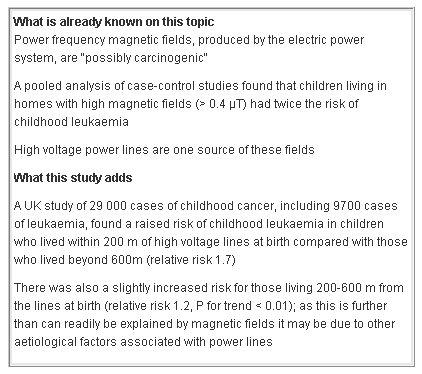
|
|
|
|
We are grateful to colleagues at the Childhood Cancer Research Group
and at National Grid Transco for help with this study and to cancer registries and the United Kingdom
Children's Cancer Study Group for notifications of cases of childhood cancer.
Contributors: GD was responsible for overall direction of the
study and publication. GD and JS had the initial idea and designed the study. TV and
MEK collected information on cases and controls and carried out the statistical analysis. JS assessed
exposures. GD and JS are guarantors.
Funding: This study was undertaken as part of a project funded
by the United Kingdom Department of Health Radiation Protection Programme. The Childhood
Cancer Research Group also receives funding from the Department of Health and the Scottish Ministers.
The views expressed here are those of the authors and not necessarily those of the Department of
Health and the Scottish Ministers. National Grid Transco provided staff time but no other
funding.
Competing interests: JS is employed by National Grid Transco
and worked on this project with their permission. A written contract exists between the
Childhood Cancer Research Group and National Grid Transco specifying that the Childhood Cancer Research
Group has complete control over the conduct, interpretation, and publication of this study; this paper
has not been approved by anyone in National Grid Transco other than JS in his capacity as
author and does not necessarily represent National Grid Transco's views.
Ethical approval: The Childhood Cancer Research Group has local
ethics committee approval and, through membership of the UK Association of Cancer Registries, has
approval from the Patient Information Advisory Group with respect to cancer registration function. |
|
|
-
Wertheimer N, Leeper E. Electrical wiring configurations and
childhood cancer. Am J Epidemiol 1979;109: 273-84.
[Abstract/Free Full Text]
-
Ahlbom A, Day N, Feychting M, Roman E, Skinner J, Dockerty J, et
al. A pooled analysis of magnetic fields and childhood leukaemia. Br J Cancer 2000;83: 692-8.
[CrossRef][ISI][Medline]
-
Maddock BJ. Overhead line design in relation to electric and
magnetic field limits. Power Engineering 1992;Sep:217- 24.
-
Morris R, Carstairs V. Which deprivation? A comparison of selected
deprivation indexes. J Public Health Med 1991;13: 318-26.
[Abstract/Free Full Text]
-
Draper GJ, Stiller CA, O'Connor CM, Vincent TJ, Elliott P, McGale
P, et al. The geographical epidemiology of childhood leukaemia and non-Hodgkin lymphomas in Great Britain,
1966-83. London: Office for Population Census and Surveys, 1991. (OPCS Studies on Medical and Population
Subjects No 53.)
-
Fews AP, Henshaw DL, Wilding RJ, Keitch PA. Corona ions from
powerlines and increased exposure to pollutant aerosols. Int J Radiat Biol 1999;75: 1523-31.
[CrossRef][ISI][Medline]
-
Feychting M, Ahlbom A. Magnetic fields and cancer in children
residing near Swedish high-voltage power lines. Am J Epidemiol 1993;138: 467-81.
[Abstract/Free Full Text]
-
Kinlen L, Doll R. Population mixing and childhood leukaemia: Fallon
and other US clusters. Br J Cancer 2004;91: 1-3.
[CrossRef][ISI][Medline]
-
Dockerty JD, Draper GJ, Vincent TJ, Rowan SD, Bunch KJ.
Case-control study of parental age, parity and socioeconomic level in relation to childhood cancers. Int J
Epidemiol 2001;30: 1428-37.
[Abstract/Free Full Text]
-
UK Childhood Cancer Study Investigators. Childhood cancer and
residential proximity to power lines. Br J Cancer 2000;83: 1573-80.
[CrossRef][ISI][Medline]
-
McBride ML, Gallagher RP, ThÚriault G, Armstrong BG, Tamaro S,
Spinelli JJ, et al. Power-frequency electric and magnetic fields and risk of childhood leukemia in Canada. Am
J Epidemiol 1999;149: 831-42.
[Abstract/Free Full Text]
-
Olsen JH, Nielsen A, Schulgen G. Residence near high voltage
facilities and risk of cancer in children. BMJ 1993;307: 891-5.
-
Tynes T, Haldorsen T. Electromagnetic fields and cancer in children
residing near Norwegian high-voltage power lines. Am J Epidemiol 1997;145: 219-26.
[Abstract/Free Full Text]
-
Kleinerman RA, Kaune WT, Hatch EE, Wacholder S, Linet MS, Robison
LL, et al. Are children living near high-voltage power lines at increased risk of acute lymphoblastic
leukemia? Am J Epidemiol 2000;151: 512-5.
[Abstract/Free Full Text]
-
Greenland S, Sheppard AR, Kaune WT, Poole C, Kelsh MA. A pooled
analysis of magnetic fields, wire codes, and childhood leukemia. Epidemiology 2000;11: 624-34.
[CrossRef][ISI][Medline]
|
BMJ - British Medical Journal
BMJ 2005;330:1290 (4 June), doi:10.1136/bmj.330.7503.1290
http://www.bmj.com/cgi/content/full/330/7503/1290 |
|







